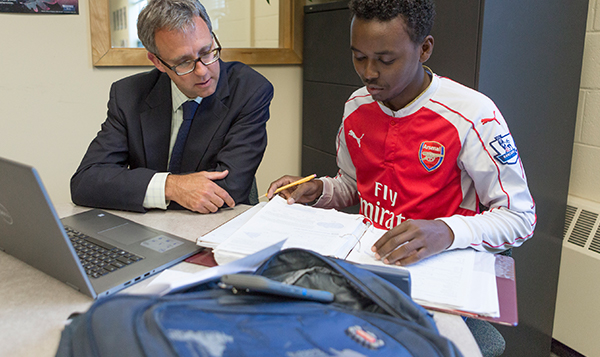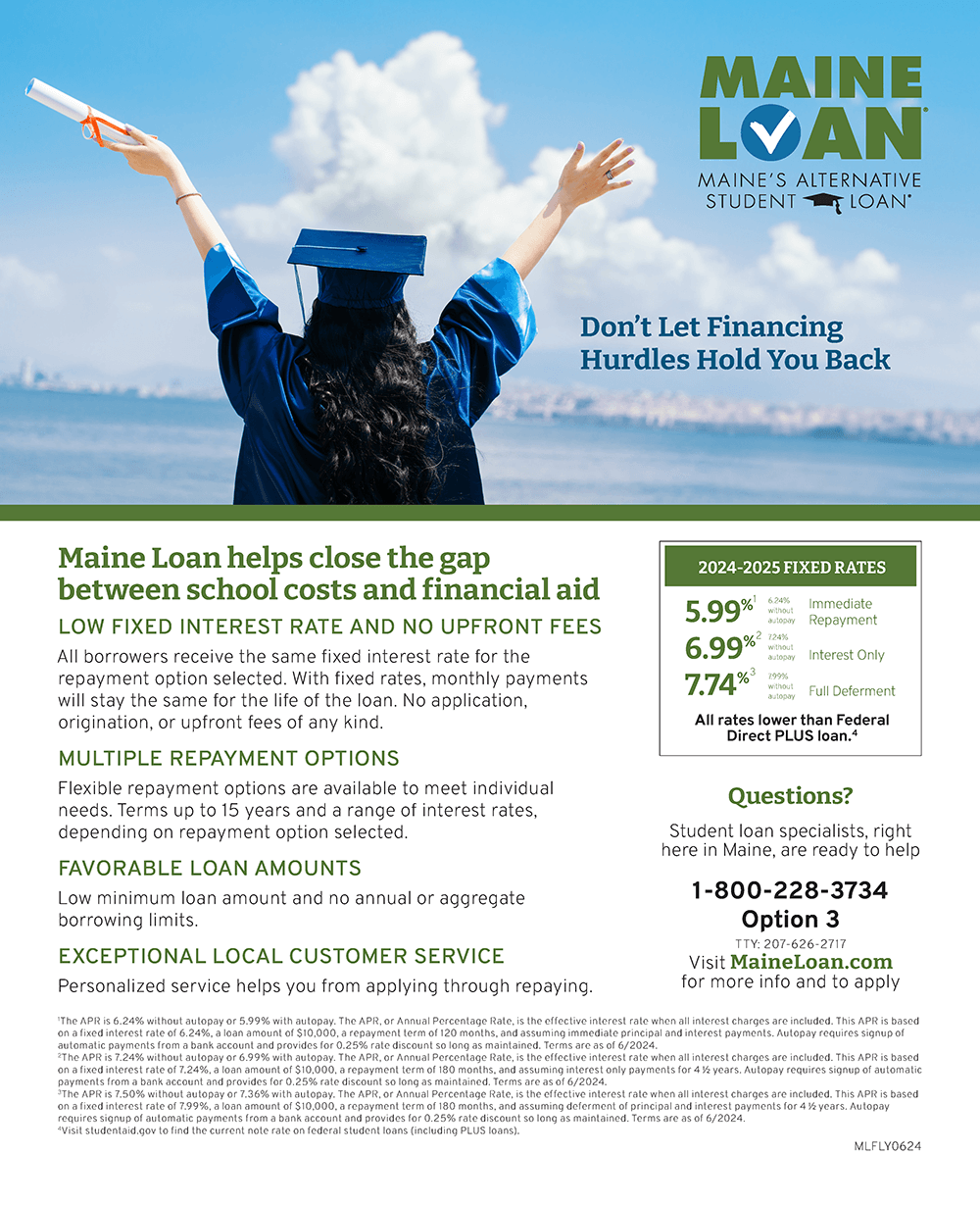You’ve decided that borrowing will be part of the way you pay for higher education. This section explains what types of loans are available and what you can expect.
Different Types of Loans
There are different types of loans available to pay for education after high school.
Generally, loans fall into two categories: federal student loans and private student loans.
Federal Student Loans
Federal student loans are provided by the federal government, and some are often included in your financial aid offer. Since federal student loans have many benefits including flexible repayment options and income-driven repayment plans, they typically should be considered first. The student is the primary borrower and is responsible for repaying the loan.
A Subsidized Federal Direct Stafford Loan is a federal loan available to undergraduate students with financial need. It is subsidized because the government pays the yearly interest while you’re in school. The amount a student can borrow increases with grade level.
An Unsubsidized Federal Direct Student Loan is a federal loan made to eligible undergraduate, graduate, and professional students, but eligibility is not based on financial need. It is unsubsidized because the borrower pays the yearly interest while they are in school. The amount a student can borrow is different based on grade level.
Federal Direct PLUS Loans are federal loans that graduate/professional degree students and parents of dependent undergraduate students can use to help pay for education expenses. The parent (or the graduate/professional student, if applicable) is the primary borrower and is responsible for repaying the loan.
Private Student Loans
Private student loans are non-federal loans, made by a lender such as a bank, credit union, state agency, or school. The student is typically the primary borrower and is responsible for repaying the loan.
Most students require a creditworthy cosigner, such as a parent. Both the student and the cosigner (if student borrower fails to make payments) are responsible for repayment of a private student loan.
Understand the Answers to These Questions for Each Private Student Loan You’re Considering
Annual Percentage Rate (APR)
The APR is the cost of interest and fees on a loan expressed over time. The APR is intended to assist you in comparing the cost of various loans that have different fees, rates, and payback periods.
Comparing Private Student Loans
Where each type of federal loan has set features and interest rates, private loans have different features depending on the individual lender. That’s why it’s important to compare loan features, interest rates, and fees in order to choose the best loan for you.
Here are some questions to help you compare private student loans.
Should I look for a student loan with a fixed or a variable interest rate?
It depends. Consider:
Fixed-rate student loans:
- May carry a higher rate than variable-rate student loans.
- Are not impacted by interest rate changes.
- Provide consistent monthly payments for the life of the loan.
Variable-rate student loans:
- Are impacted by interest rate changes.
- Rates can change monthly or quarterly depending on the loan terms and could change frequently over the typical repayment period of 10 to 15 years.
- May actually be less expensive than fixed-rate loans, depending on the interest rate environment over the payback period.
Which type of rate, fixed or variable, is right for me?
It depends. If you can pay off your student loan debt quickly, a variable-rate student loan may be a cost-saving solution if the rate is lower than the available fixed rate and does not increase above the available fixed rate during the repayment period. Just remember, the longer it takes you to pay off the loan, the more opportunity there is for variable interest rates to change. You may lower the risk of your interest rate increasing by looking for a lender that caps variable rates.
A fixed-rate student loan may make it easier to plan and budget for since your monthly payment will remain the same for the life of the loan.
How are variable interest rates determined?
Variable interest rates are often tied to common indices like the Prime Rate or SOFR (Secured Overnight Financing Rate) and can change as frequently as every 30 to 90 days. For example, for loans with rates tied to the Prime Rate, when the Prime Rate goes up, the interest rate of that loan subsequently rises and when the Prime Rate goes down, the interest rate will subsequently decrease.
Are fixed rates stable (remaining the same) through the life of the loan?
Yes. The fixed interest rate remains constant throughout the life of the loan. In a rising-interest-rate environment, this can be comforting. In a decreasing-interest-rate environment, this can be concerning.
What information will I need to complete my application?
For both the borrower and co-borrower:
- Social security number
- Date of birth
- Phone number
- Email address
- Current and prior addresses
- Monthly income
- Housing costs
- Employment information
What is the estimated time it takes from the date of the online loan application to approval of the loan?
The online application takes approximately 40 to 60 minutes to complete and initial approval is often determined at that time. There may be some loans that require additional review or income verification before receiving a final approval.
What is a credit score?
Before making a private loan, a bank or financial institution will attempt to determine your “creditworthiness.” Creditworthiness is the likelihood that you’ll pay back the money you borrowed in a timely and responsible manner. To help financial institutions determine your creditworthiness, they will access your credit report and credit score. The most well-known credit score is known as a FICO® Score. You will have three credit scores, one for each of the three credit-reporting agencies: Experian, TransUnion, and Equifax. A credit score can range from 300 to 850, with 850 being the highest score available. The higher your credit score, the more likely you are to be approved for credit or offered favorable loan terms. For more information, visit www.annualcreditreport.com.
If my parents or I have placed a credit freeze on our credit reports, will it impact my ability to apply for student loans?
Private and alternative student loans are credit-based and will be impacted by a credit freeze. You will need to remove the freeze to allow lenders to check your credit history.
Other questions about the lender
What is the quality of the lender’s customer service?
When you have questions, how do you want them answered? Personal assistance and online capabilities to get your questions answered in a timely manner are important. Find a lender that provides the service you expect when you need it.
How long has the lender been in business? Do they have a good reputation?
This can also be a good indicator of the quality of customer experience you can expect to receive.
Will the lender hold on to your loan or sell it to another group?
If it is sold, learn about what loan terms and benefits might change with your new lender. It can be helpful to work with the same lender from application through your loan being paid in full.
Loan Comparison Tools
Here are some tools to help you quickly see differences in some of the student loan options that may be available to you:
- See the comparison table below
- Use Maine Private Education Loan Network Lender comparison tool
- Federal Student Aid’s website provides information on specific types of federal loans
| Student Loan | Origination or Loan Fee | Fixed Rate | Variable Rate | Repayment Options | Term | Customer Service | Auto-Pay Discounts | Prepayment Penalty |
|---|---|---|---|---|---|---|---|---|
| Lenders in the Maine Private Education Network | 0 – 4% | No | Yes | Immediate, Interest Only, Full Deferment | Up to 15 years | Originated by local Maine lender | Yes, some lenders | No |
| Maine Loan | 0% | Yes. 6.24%1 Fixed, Immediate Repayment; 7.24%2 Fixed, Interest-Only Payments; 7.99%3 Fixed, Full Deferment | No | Immediate, Interest Only, Full Deferment | 10 – 15 years | FAME | Yes4 | No |
| Federal Direct (Parent/ Grad) PLUS | 4.228% (10/1/22- 6/30/24) | Yes. 8.05% Fixed (7/1/23- 06/30/24) (This is updated on July 1, each year) | No | Immediate, Full Deferment | 10 years | Federal Loan service provider | No | No |
2The APR is 7.24% without autopay and 6.99% with autopay. The APR, or Annual Percentage Rate, is the effective interest rate when the guarantee fee and all interest charges are included. This APR is based on a fixed interest rate of 7.24%, a loan amount of $10,000, and a repayment term of 180 months, and assuming interest only payments for 4 1/2 years. Terms are as of June 2024.
3The APR is 7.50% without autopay and 7.36% with autopay. The APR, or Annual Percentage Rate, is the effective interest rate when the guarantee fee and all interest charges are included. This APR is based on a fixed interest rate of 7.99%, a loan amount of $10,000, and a repayment term of 180 months, and assuming deferment of principal and interest payments for 4 1/2 years. Terms are as of June 2024.
4An interest rate reduction of 0.25% is available to borrowers. To qualify, borrowers need to arrange with the loan servicer to have their payments automatically withdrawn from a checking or savings account. This interest rate reduction will remain on the account unless the loans are in a status which does not require payments, or automatic deduction is revoked by the borrower or suspended by the loan servicer according to the insufficient funds policy in effect when the agreement is signed.





